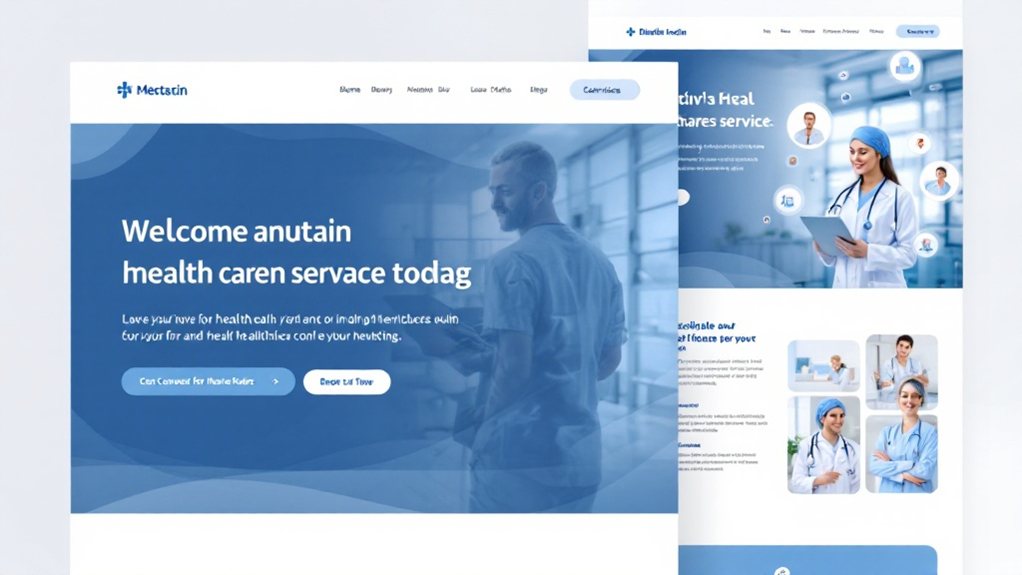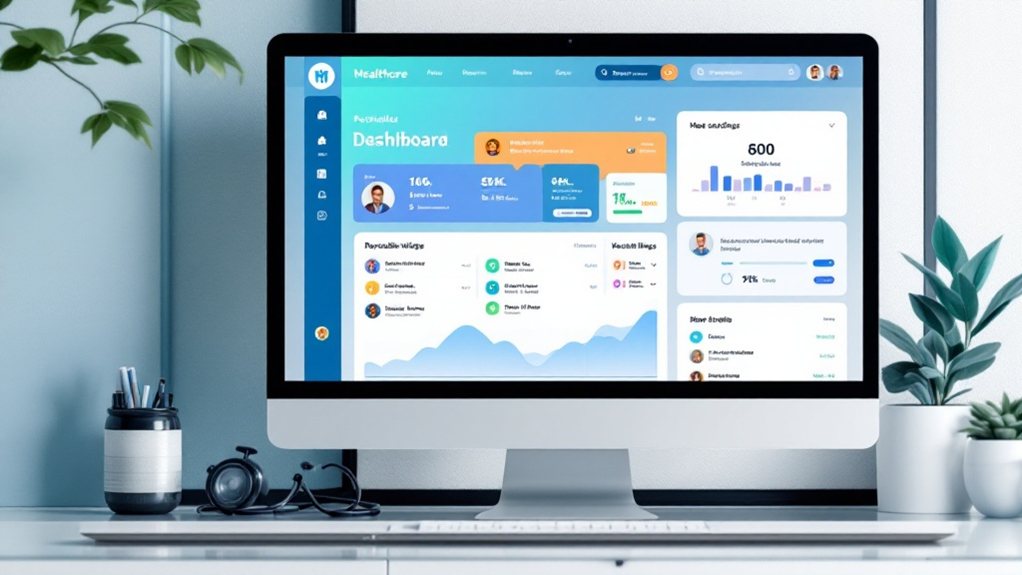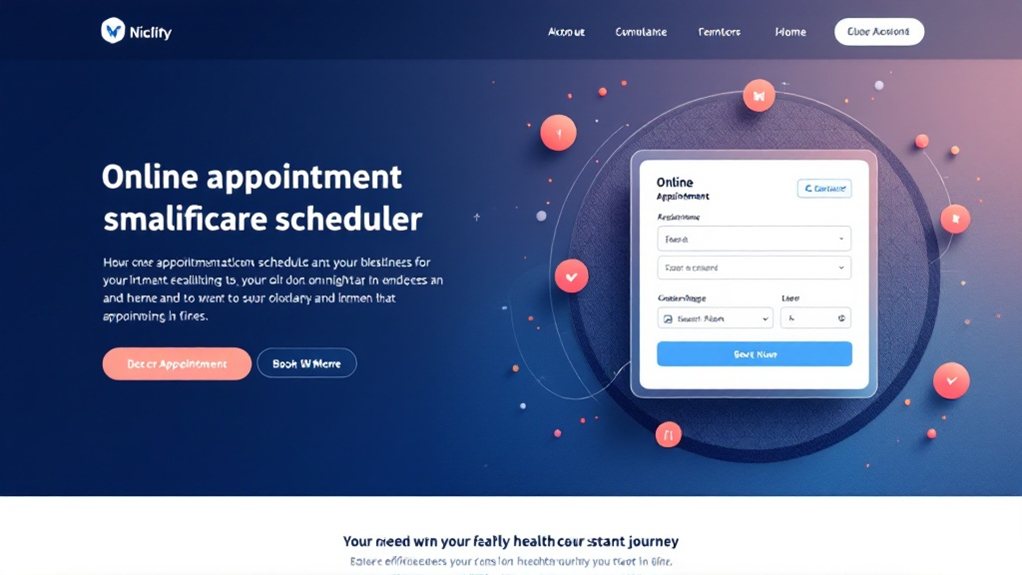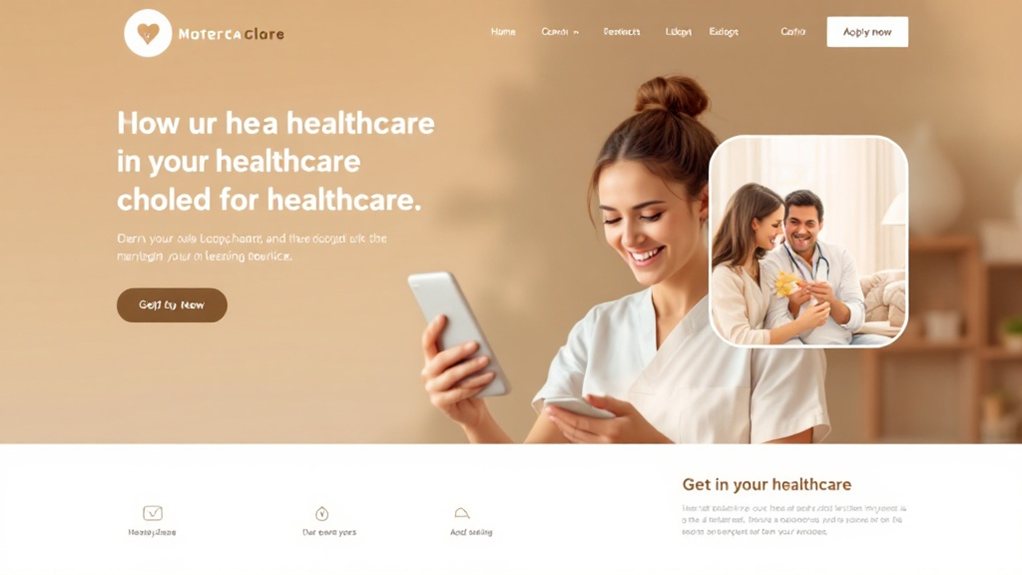Crafting a user-friendly healthcare website requires intuitive navigation, responsive and mobile-friendly design, clear and concise content, accessibility for all, and personalized features. You'll want straightforward labeling, logical layout, and seamless mobile access. Use plain language, high-contrast visuals, and multiple content formats. Empower patients with customizable options and streamlined processes. By focusing on these key elements, you'll deliver a superior digital experience that truly resonates with your users. Continue reading to uncover more strategies for optimizing your healthcare website.
Key Takeaways
- Intuitive navigation with clear layout, logical content grouping, and responsive design for seamless access on any device.
- Responsive and mobile-friendly design that enhances usability, reduces bounce rates, and delivers a superior user experience.
- Concise and well-organized content with prioritized details, scannable formatting, and plain language to prevent information overload.
- Accessibility features, including text alternatives, keyboard-only navigation, high-contrast color schemes, and multiple content formats.
- Personalized and customizable features that empower patients, foster engagement, and create a truly resonant user experience.
Intuitive Navigation

A user-friendly healthcare website prioritizes intuitive navigation, ensuring you can easily find the information you need. Clear and consistent page layout with logical grouping of content helps you quickly locate relevant sections. Straightforward labeling of navigation menus and intuitive icons guide you through the website seamlessly. Responsive design adapts the layout to your device, maintaining accessibility on any screen size. Intuitive search functionality allows you to find specific topics or services with ease. Overall, the navigation should feel natural and effortless, enabling you to access healthcare information and resources efficiently.
Responsive and Mobile-Friendly Design
With the increasing reliance on mobile devices, a responsive and mobile-friendly design is essential for a user-friendly healthcare website. Patients expect to access healthcare information and services seamlessly on their smartphones and tablets. A responsive design ensures your website automatically adjusts its layout and content to provide an optimal viewing experience across various screen sizes. This not only enhances usability but also boosts engagement and reduces bounce rates. Additionally, a mobile-friendly design should prioritize easy navigation, clear call-to-action buttons, and quick page load times. By prioritizing responsive and mobile-friendly features, you can deliver a superior user experience and better serve your patients' needs.
Clear and Concise Content Organization

While a clear and concise content organization is crucial for a user-friendly healthcare website, you don't want to overwhelm visitors with excessive information. Prioritize the most essential details and structure your content in a logical, easy-to-navigate way. Use clear headings and subheadings to guide users, and break up text with bullet points or short paragraphs. Avoid jargon and technical terms, and stick to plain, straightforward language. Make sure your content is scannable, with key points highlighted. This will help users quickly find the information they need without feeling inundated. Clear organization and concise messaging are the cornerstones of a user-friendly healthcare website.
Accessibility for All Users
Ensuring your healthcare website is accessible to all users, regardless of their abilities or disabilities, is paramount. Implement accessible design principles like providing text alternatives for non-text content, ensuring keyboard-only navigation, and using high-contrast color schemes. Optimize your site for screen readers and other assistive technologies. Offer clear, easy-to-understand language and avoid jargon. Provide multiple ways for users to access information, such as text, audio, and video. Regularly test your site's accessibility and make improvements. Prioritizing inclusivity widens your audience and ensures everyone can engage with your healthcare resources.
Personalized and Customizable Features

Your healthcare website should offer personalized and customizable features that cater to your users' unique needs and preferences. Allow them to tailor the layout, color scheme, and content to their liking. Provide personalized health recommendations, treatment plans, and appointment scheduling based on their medical history and preferences. Enable users to set reminders, track progress, and access their medical records securely. Personalization and customization empower patients, foster engagement, and improve their overall experience. Embrace these features to create a user-friendly healthcare website that truly resonates with your audience.
Seamless Integration With Healthcare Systems
Seamlessly integrating your healthcare website with existing systems is crucial for a user-friendly experience. Patients expect to access their records, schedule appointments, and communicate with providers without any hassle. By integrating your website with electronic medical record (EMR) systems, you can streamline these processes, reducing frustration and improving patient satisfaction. Additionally, connecting your website to appointment scheduling software ensures real-time availability, allowing patients to conveniently book their visits. Smooth integration also enables secure messaging between patients and healthcare teams, fostering better communication. Ultimately, a cohesive digital ecosystem that aligns with patients' expectations is vital for delivering a delightful user experience and driving engagement with your healthcare services.
Secure and Confidential Data Management

Patients' sensitive health information must be safeguarded when designing your healthcare website. Implement robust security measures like encryption and access controls to protect data from unauthorized access. Ensure compliance with industry regulations like HIPAA to maintain confidentiality. Provide clear privacy policies that explain how you handle personal data. Empower patients to manage their information, allowing them to review, update, and delete records as needed. Continuously monitor your systems and promptly address any security vulnerabilities. Earn patients' trust by demonstrating your commitment to data privacy and security throughout the website experience.
Engaging and Informative Visual Elements
Engaging and visually appealing elements can captivate users and enhance their overall experience on your healthcare website. Utilize high-quality, relevant images and graphics that complement the content and convey your brand's professionalism. Incorporate informative infographics to present complex medical information in a clear, easy-to-understand format. Leverage visual cues, such as icons and color-coding, to guide users through the website and highlight important information. Ensure that all visual elements are accessible and optimized for various devices and screen sizes. By thoughtfully integrating engaging and informative visuals, you can create a user-friendly healthcare website that engages visitors and effectively communicates your valuable services.
Streamlined Appointment Scheduling Processes

After captivating users with visually engaging elements, it's time to focus on streamlining the appointment scheduling process. Patients shouldn't have to navigate a labyrinth of forms and drop-down menus. Instead, provide a straightforward, user-centric scheduling experience. Allow patients to quickly book appointments with their preferred providers, view available slots, and receive instant confirmation. Integrate with calendars and offer mobile-responsive tools. Simplify rescheduling and cancellations. Ensure real-time updates on appointment status. Seamless scheduling is crucial for a positive healthcare website experience. By optimizing this critical touchpoint, you'll enhance patient satisfaction and encourage continued engagement with your services.
Effective Search and Filtering Capabilities
Once patients arrive on your healthcare website, ensure they can easily locate the information or services they need. Implement an effective search function that allows users to quickly find what they're looking for. Complement this with intuitive filtering capabilities, enabling patients to narrow down options based on criteria like specialty, location, or availability. Carefully structure your website's navigation, categorizing content logically and placing crucial elements prominently. Regularly review analytics to identify popular search terms and adjust your site accordingly. By prioritizing user-centric search and filtering, you'll empower patients to efficiently find the healthcare resources that meet their specific needs.
Proactive Communication and Feedback Mechanisms

To foster a strong connection with your patients, implement proactive communication and feedback mechanisms on your healthcare website. Encourage users to share their thoughts, concerns, and preferences through prominently displayed contact forms, live chat, and user surveys. Promptly respond to inquiries, addressing each query with empathy and personalization. Incorporate user feedback into your website's continuous improvement, showcasing how you've implemented suggestions. Enable patients to rate their experience and provide detailed reviews, which enhance transparency and build trust. Leverage email and push notifications to proactively inform users of appointment reminders, prescription refills, and relevant health updates. By prioritizing open dialogue, you'll demonstrate your commitment to patient-centric care and foster lasting relationships.
Continuous Usability Testing and Optimization
Continuously testing the usability of your healthcare website and optimizing it based on user feedback is crucial for providing an exceptional patient experience. By regularly conducting usability studies, you can identify pain points and gather valuable insights to enhance your site's navigation, content, and overall functionality. Remember, your patients' needs and preferences should drive your design decisions. Iterate and refine your website continuously, addressing any issues promptly. Leverage analytics to track user behavior and measure the impact of your changes. Embracing a culture of continuous improvement will ensure your healthcare website remains user-friendly, engaging, and effective in meeting your patients' evolving needs.

